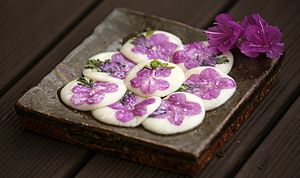Hwajeon facts for kids

Jindallae-hwajeon (pan-fried Korean rhododendron rice cakes)
|
|
| Type | Jeon, tteok |
|---|---|
| Place of origin | Korea |
| Associated national cuisine | Korean cuisine |
| Main ingredients | Edible flowers, glutinous rice flour, honey |
| Korean name | |
| Hangul |
화전
|
|---|---|
| Hanja |
花煎
|
| Revised Romanization | hwajeon |
| McCune–Reischauer | hwajŏn |
| IPA | [hwa.dʑʌn] |
| Hangul |
꽃부꾸미
|
| Revised Romanization | kkot-bukkumi |
| McCune–Reischauer | kkot-pukkumi |
| IPA | [k͈ot̚.p͈u.k͈u.mi] |
| Hangul |
꽃지지미
|
| Revised Romanization | kkot-jijimi |
| McCune–Reischauer | kkot-chijimi |
| IPA | [k͈ot̚.t͈ɕi.dʑi.mi] |
Hwajeon (화전; 花煎), also known as flower cake, is a special Korean treat. It's a small, pan-fried rice cake made with sticky rice flour, honey, and colorful edible petals. People often enjoy hwajeon during traditional festivals like Samjinnal and Buddha's Birthday.
Contents
What Does Hwajeon Mean?
The name hwajeon (화전; 花煎) comes from two hanja characters. The first part, hwa (화; 花), means "flower." The second part, jeon (전; 煎), means "something pan-fried." So, hwajeon literally means "flower pan-fry" or "flower cake."
There are also other Korean names for this dish. Kkot-bukkumi (꽃부꾸미) and kkot-jijimi (꽃지지미) are similar. Kkot (꽃) means "flower" in native Korean. Bukkumi (부꾸미) is a type of pan-fried rice cake, and jijimi (지지미) means "pancake."
Different Kinds of Flower Cakes
Hwajeon is made with different edible petals depending on the season. This makes each cake unique and colorful!
Spring Flowers
In spring, people use flowers like:
- Rhododendron (Jindallae-hwajeon)
- Pear flower (Ihwa-jeon or Baekkot-hwajeon)
- Goldenbell flower (Gaenari-hwajeon)
- Cherry blossom (Beotkkot-hwajeon)
- Violet (Jebikkot-hwajeon)
Summer and Autumn Flowers
When summer arrives, roses are used for Jangmi-hwajeon. In autumn, people often make hwajeon with:
- Chrysanthemum (Gukhwa-jeon)
- Cockscomb (Maendeurami-hwajeon)
Winter Alternatives
During winter, when fresh flowers are hard to find in Korea, people get creative! They use other ingredients like:
- Mugwort leaves
- Waterdropwort leaves
- Rock tripe
- Jujubes (a type of fruit)
These are often cut into flower shapes to keep the tradition alive.
How Hwajeon is Made
There are two main ways to prepare these delicious flower cakes:
- Simple Pan-Frying: First, sticky rice is seasoned with salt and ground into a fine flour. Then, it's mixed with boiling water to make a soft dough. Small, round, flat cakes are shaped from this dough. These are pan-fried in sesame oil. While the cakes are cooking, pretty flower petals are gently placed and pressed onto the dough.
- Royal Court Style: In the past, the Korean royal court used a slightly different method. Fine sticky rice flour was kneaded into a thicker dough. This dough was rolled out into sheets about 5 millimeters (0.2 inches) thick. Flower petals were placed on the dough and lightly pressed. Then, a special tool called a hwajeon-tong, similar to a cookie cutter with a 5-centimeter (2-inch) diameter, was used to cut out the flower cakes. These cakes were then fried in sesame oil.
After frying, the warm flower cakes are often soaked in honey to make them sweet. A sprinkle of cinnamon powder is added for extra flavor.
Hwajeon Nori: Flower Cake Play
Hwajeon nori means "flower cake play." It's a fun old tradition where people go on picnics to the mountains or countryside. They do this to enjoy the beautiful seasonal flowers, especially in spring and autumn.
Spring Picnics
In spring, women used to pack sticky rice flour and a griddle. They would go on a picnic near a stream on Samjinnal. This festival happens on the third day of the third lunar month in the Korean calendar. They would pick fresh spring blossoms and make hwajeon right there! The hwajeon made with rhododendron flowers is the most famous type. People traditionally enjoyed it with rhododendron punch, a sweet drink with rhododendron flowers floating in honeyed or magnolia berry water.
Autumn Celebrations
Similarly, people enjoyed hwajeon nori in autumn. They would make hwajeon with chrysanthemum flowers and leaves. This was often enjoyed with chrysanthemum wine or yuja punch. This custom is closely linked to Junggu, a traditional holiday on the ninth day of the ninth lunar month.
These lovely traditions of enjoying flower cakes and nature go way back! They started in the Three Kingdoms era (57 BCE ‒ 668 AD), specifically in the ancient kingdom of Silla.
See also
 In Spanish: Hwachon para niños
In Spanish: Hwachon para niños

